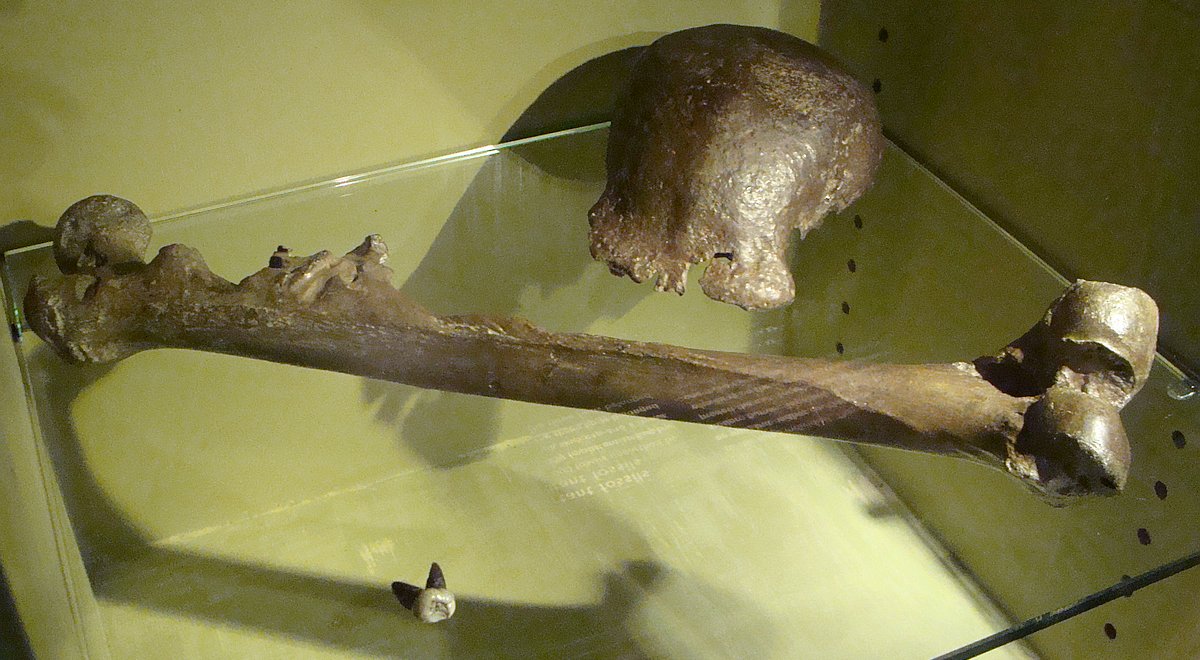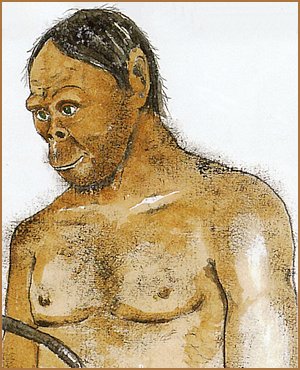Who was ‘Java man’?
 |
 |
Late last century a Dutch physician, Eugene Dubois, set sail to the Dutch East Indies (now called Indonesia). Completely enamoured by the theory of evolution, he had come to believe for some reason that he would find the elusive ‘missing link’ between humans and apes in that part of the world.
In 1892 on the island of Java, he found a thigh-bone, which to all intents and purposes was like that of modern humans. About a year earlier in the same location he had found a large skull-cap, and later three teeth. These were not necessarily from the same individual: the skullcap and the leg-bone were about 15 metres (50 feet) apart.

The creature from which the skullcap came appeared to have had a brain size of 900 cc (about two-thirds that of the average modern man—one must of course allow for the difficulty of estimating brain size from only a part of the skull). There is no reason to insist that the skullcap and the leg bone came from the same individual. But Dubois had found his ‘missing link’ and it eventually became widely accepted as such, in spite of the fact that a leading authority had identified two of the teeth as those of an orangutan, and the other as human.
‘Java man’ was trumpeted around the world as indisputable proof of human evolution. Textbooks and magazines were filled with fanciful reconstructing of ‘Java man’, who had been given the impressive-sounding scientific name of Pithecanthropus erectus (‘erect ape-man’).
Naturally, the bones did not show whether their owner (or owners) had much body hair or not. Yet drawings of ‘Java man’ all showed the required amount of hair, the usual club in the hand, and so on. Although no face bones had been found, suitably ‘half-ape, half-man’ features were reconstructed in artists’ drawings.
Other skulls found

For a full 30 years, Dubois did not announce to the scientific community that he had also found two human skulls in the same general location and level in a gravel deposit. These were the so-called Wadjak skulls. Many have said that this was because he knew it would detract from the readiness with which his ‘Java man’ find would be accepted as man’s ancestor. However, from his own writings and other sources, Dubois apparently had a suspicious nature, and even locked his ‘Java man’ find away for years, even though many were convinced it was the ‘missing link’.
‘Java man’ has been renamed so as to now belong to the category of Homo erectus. However, readers should be aware that though there are indeed reasonable specimens which have been named Homo erectus (of disputed status in this whole question, but that’s another matter) there is no reason to believe that ‘Java man’ necessarily even belonged to this category, nor had any objective existence at all.
The skullcap may have belonged to a large extinct ape, and the leg bone to an ordinary human. Unfortunately, the occasional reference text still features ‘Java man’ as somehow evidence of an evolutionary origin of man.
Did Dubois recant? Revising the record
Evolutionist articles of textbooks and anthropological journal articles have often written that Dubois eventually renounced his ‘Java man’ and claimed it was merely a giant gibbon. Such authorities have naturally been quoted to this effect in creationist works.

New information uncovered by that persistent iconoclast of evolutionism, Stephen Jay Gould, shows beyond doubt that this is a misleading picture.1
Dubois had a highly eccentric theory of human evolution, which demanded a precise mathematical relationship between increasing brain size and body weight. In fact, by insisting that his ‘Java ape-man’ had the proportions of a gibbon (thus changing the reconstructed body-weight) he was ensuring that the ratio would fit neatly into his (erroneous) mathematical series. The purpose was to more firmly cement its status as a perfect ‘link’. Dubois himself is quoted as having written in 1932:
’Pithecanthropus was not a man, but a gigantic genus allied to the gibbons … I still believe, now more firmly than ever, that the Pithecanthropus of Trinil is the real “missing link.”1
The idea that Dubois changed his mind about ‘Java man’ will die hard, among both evolutionists and creationists.
Reference
- Gould, Stephen Jay, ‘Men of the Thirty-Third Division’, Natural History, April, 1990, pp. 12–24. Return to text.













Readers’ comments
Comments are automatically closed 14 days after publication.